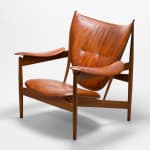

Finn Juhl Denmark, 1912-1989
Chieftain Armchair, 1949
Teak and leather
94 x 105 x 85 cm
37 1/8 x 41 3/8 x 33 1/2 in
37 1/8 x 41 3/8 x 33 1/2 in
Made for the Cabinetmakers Guild exhibition in 1949 the « Chieftain Chair » is one of the most distinctive pieces of furniture made by Finn Juhl and probably his most...
Made for the Cabinetmakers Guild exhibition in 1949 the « Chieftain Chair » is one of the most distinctive pieces of furniture made by Finn Juhl and probably his most important creation. Executed by renowned cabinetmaker Niels Vodder, the wooden frame of the chair was inspired by forms from weapons and utilitarian objects of « primitive » people, giving it a smooth and very organic shape. The design of the« Chieftain Chair » was made according to strictly scientific principles to ensure maximum comfort.
The structure of the chair seems to defy gravity showing the seated person looked like they were floating. Finn Juhl strove to create a visual disconnection between the supportive elements of the chair and the surfaces that carried the seater. This composition became one of his hallmarks, as he found the perfect balance between stability and delicate sculptural form.
The story behind the « Chieftain » nickname is that after King Frederik IX had tried the chair, a journalist asked Finn Juhl if he would call it the King’s chair and Finn Juhl objected that it was too pretentious that « you had better call it a chieftain’s chair »
The structure of the chair seems to defy gravity showing the seated person looked like they were floating. Finn Juhl strove to create a visual disconnection between the supportive elements of the chair and the surfaces that carried the seater. This composition became one of his hallmarks, as he found the perfect balance between stability and delicate sculptural form.
The story behind the « Chieftain » nickname is that after King Frederik IX had tried the chair, a journalist asked Finn Juhl if he would call it the King’s chair and Finn Juhl objected that it was too pretentious that « you had better call it a chieftain’s chair »

